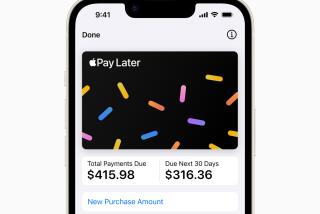Airline Flier Plan Has Her Grounded
- Share via
Question: Last September, I responded to a full-page ad in The Times by calling Continental Airlines to enroll my daughter in their special college student “flight bank” program. I had thought the cost was $25, but $40 was charged to my Citibank Visa card.
To this date, she has received nothing from Continental. I have called them repeatedly. In February, I finally got someone to send a Telex to the operations manager, and I followed this up with a letter dated Feb. 12.
At this point, I just want a refund of my $40. My daughter is going to graduate before she will be able to take advantage of this program. I think I have been treated very badly in this whole matter.--N.L.
Answer: Well, on that score, at least--that you’ve been treated badly--you’ll get no argument from Rick Scott, Continental’s public relations spokesman at the airline’s headquarters in Houston. You somehow fell through a crack that dwarfs the San Andreas fault.
Program Launched
Continental’s Collegiate Flight Bank program was launched, sure enough, last fall with great gusto and entailed a non-refundable $10-per-year annual fee (which was to go up to $15 a year after Jan. 1, 1987, and which, indeed, did).
Why you were charged $40 instead of $10, Scott feels (and it’s admittedly conjecture on his part), would seem to be based on the fact that, once enrollment was made before the Jan. 1, 1987, deadline, the $10-a-year fee was locked in at $10 for as long as four years--as long as your daughter remained in college--and someone apparently signed her up for the four full years in one fell swoop.
What she was supposed to get was a membership kit that contained an embossed, personalized membership card, a $25 discount certificate immediately usable on any mainland Continental flight, a subscription to Continental’s Business Week Career magazine, a 10% discount on all future Continental flights during the length of her membership and automatic membership in a mileage-credit program that is similar to the better-known frequent-flier programs. “Only more liberal,” in Scott’s words.
Where the usual frequent-flier program kicks in--and rewards the participant with a free round trip to anywhere Continental flies--at about 35,000 miles, the collegiate plan gives your daughter a free round trip anywhere in the continental United States after eight trip segments, or after 12,000 miles. Or would have so rewarded her, if someone within Continental had actually signed her up.
I took the liberty of putting Scott in touch with you, which, he assured me later, he had done, and a refund of your $40 is now in the works. (Although the collegiate plan is still operative, if, in the meantime, your daughter hasn’t become too disinterested--or creaky with age--to take advantage of it.)
Q: You wrote a column entitled “Fast Payoff of Mortgage Saves Bundle in Interest” a little more than a year ago. I’ve heard that paying semimonthly will have the same effect--i.e., $1,000 a month, or $500 on the first and $500 on the 15th. Can you explain this?--W.S.
A: Ah, the Wonder World of Mathematics where two halves can, and frequently do, add up to more than the whole.
Technically, it’s not really a “semimonthly” pay schedule, but a “biweekly” pay schedule--a subtle, but important, difference. “Semimonthly,” that is, means twice a month, whereas “biweekly” means every other week.
We have Canadian credit unions to thank for inventing the biweekly mortgage, partially because the biweekly pay schedule is heavily favored north of the border, but more importantly, because mortgage interest is not tax deductible in any way under Canadian law.
With no tax shelter involved, then, Canadians are particularly sensitive about paying lenders interest that--on a 30-year mortgage--commonly amounts to twice (or more) of the amount actually borrowed. (On a 30-year, $100,000, mortgage at 10% interest, for instance, you will have repaid the lender a fat $316,000 at the end of 30 years--$216,000 of it in pure interest.)
The math of the biweekly payoff is fascinating. Why on earth, if your monthly payments are $878 (as would be the case in the $100,000 mortgage example given above) would the 30-year mortgage be paid off in slightly more than 18 years by simply paying half that amount ($439) every other week? Because, believe it or not, that’s the result.
Part of it is explained by the fact that anyone getting paid biweekly is getting 26 paychecks a year (there are always two months during the year with three paydays in it) and, with a biweekly mortgage, he is making the equivalent of an extra month’s payment every year. (If it were a “semimonthly” mortgage he’d be making only 24 payments a year.)
Biweekly Mortgage
That’s part of the explanation, but no less important is the fact that with a biweekly mortgage, the reduction of the principal amount is taking place twice as often as it is with a conventional monthly mortgage payment--and it is the fast reduction of the principal amount owed that saves all that interest, increases equity in the home and cuts down the payoff time so dramatically.
Here’s an example to chew on: Suppose you had a $50,000, 30-year mortgage at 10 1/2% on which the monthly payment for principal and interest is $457.37. Let’s say, just for the heck of it, you include an extra $25 with your first month’s mortgage check. That’s the first, and only, time you make such an extra payment. At the end of 30 years, how much has this one, giddy, $25 extra payment saved you in interest? Would you believe $544.98--or 21 times the amount of the extra payment?
Why, if the biweekly mortgage is so popular in Canada--and in the half-dozen or so places in the United States where it has been introduced--don’t we see it offered more commonly?
It’s a good question. It does , of course, require the electronic transfer of funds through an arrangement between the lender and home buyer’s bank, savings and loan or credit union, because, otherwise, the paper shuffling would be impossible. But, in this age of computers, this is no longer a problem and--where it is in use--the savings to the lender are impressive: in the handling of payments received, in postage, in the printing and distribution of payment coupons or booklets and in the virtual elimination of delinquencies and defaults.
It’s a relatively new idea, of course, and, alas, mortgage lenders aren’t particularly noted for their speed in embracing new ideas.
Don G. Campbell cannot answer mail personally but will respond in this column to consumer questions of general interest. Write to Consumer VIEWS, You section, The Times, Times Mirror Square, Los Angeles 90053.
More to Read
Sign up for The Wild
We’ll help you find the best places to hike, bike and run, as well as the perfect silent spots for meditation and yoga.
You may occasionally receive promotional content from the Los Angeles Times.






